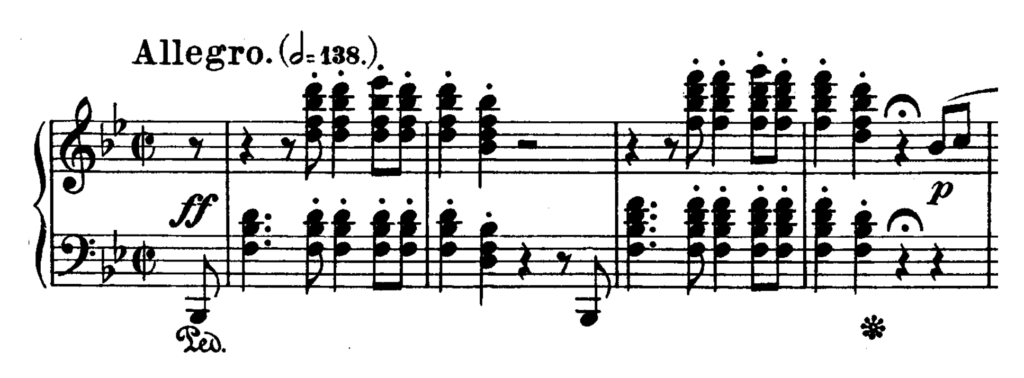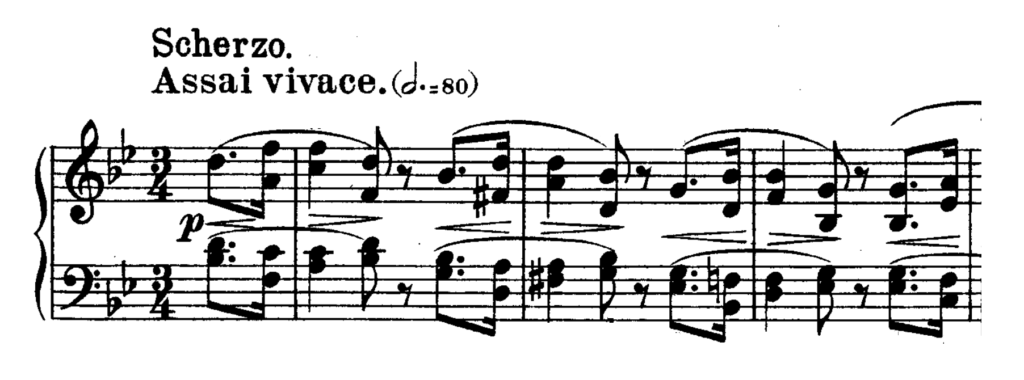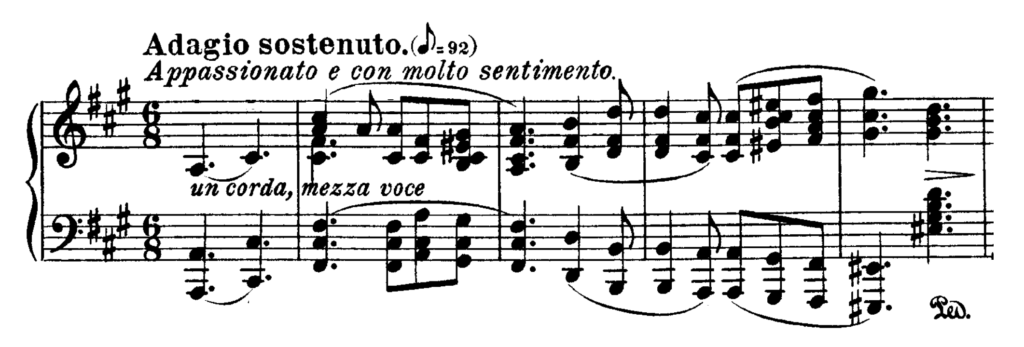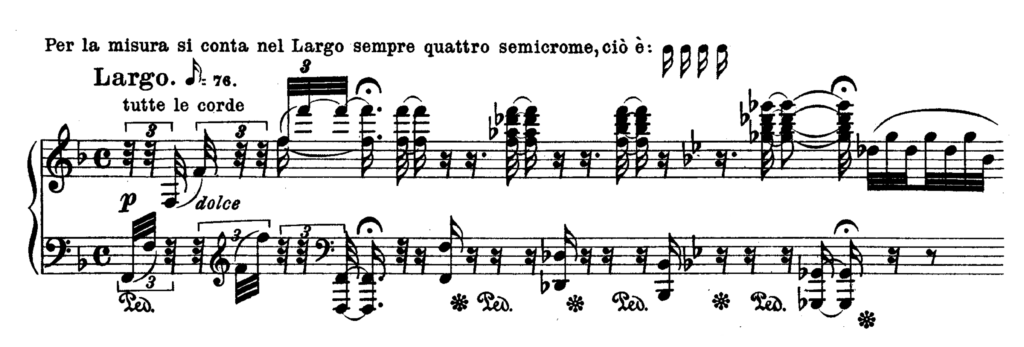Review of Beethoven Piano Sonata No 29 in B-flat Major Op 106 Hammerklavier
Assay
Contents
- ane Assay
- ane.i First Movement (Allegro)
-
- 1.i.0.1 EXPOSITION:
- 1.1.0.2 Evolution:
- 1.1.0.3 RECAPITULATION:
-
- 1.2 Second Move (Scherzo – Assai Vivace)
-
- 1.2.0.ane Commencement Office:
- 1.2.0.ii 2d PART:
- 1.ii.0.3 THIRD PART:
-
- one.iii Tertiary Movement (Adagio Sostenuto)
-
- 1.iii.0.ane EXPOSITION:
- 1.iii.0.ii Development:
- 1.3.0.3 RECAPITULATION:
-
- 1.4 4th Motility (Introduction: Largo – Allegro – Prestissimo, Allegro Risoluto)
-
- 1.4.0.1 INTRODUCTION:
- 1.four.0.2 Start PART:
- one.four.0.3 2nd PART:
- 1.4.0.4 Third PART:
-
- ane.i First Movement (Allegro)
For the benefit of all pianists learning this piece of work, nosotros nowadays to you a concise and like shooting fish in a barrel to apply analysis of Beethoven's Pianoforte Sonata No.29 in Bb Major Op.106 "Hammerklavier"
First Movement (Allegro)
Grade: Sonata Form. Bb Major.


EXPOSITION:
Bars 1-xviii: Commencement Subject in B apartment major (tonic).The first bailiwick is in ii sections; the first department, Bars 1-5; the second department, Bars 5-9, catastrophe on ascendant; the latter department is repeated and elongated, ending with total shut on tonic.
Bars eighteen-64: Connecting Episode.The connecting episode commences with a subject of two bars, which is repeated three times with different harmony, Bars 18-25. A passage closely post-obit, beginning in octaves and ending on the ascendant, prepares the ear for a reference to the first phrase of the start subject, the rhythm of which is used for a modulation to D major, Bars 37-39. Bars 39-46 are formed upon the dominant chord of G major, in the cardinal of which an episode follows, which leads to the 2d bailiwick, Bars 46-64
Bars 63-101: 2d Subject in One thousand major.The 2nd subject begins with the melody in an inner office. (Annotation that the concluding iii notes of the bass of the preceding episode (Bars 63-64) besides grade the outset three notes of the second subject, Bars 63-64). Confined 63-67 are repeated, Bars 67-71, contradistinct to cease in East small. A sequential passage modulating into D modest, C major, B minor, A major, and G major, Bars 71-75, leads to two confined in the latter cardinal (repeated) followed by two confined modulating to D major. These half dozen bars are repeated in different octaves, Bars 82-87, and followed by a sequential passage, Confined 88-91, leading to a modulation to C major (where a new effigy is introduced, Bars 92-93). This shortly gives identify to iv confined in the key of G, which end the second subject.
Bars 101-121: Coda.The Coda begins with a new subject of six bars, repeated (varied), Confined 107-112. A passage first with the ascendant seventh of C major brings the first function to an cease in G major (Bar 121).
Bars 121- 126:Passage leading to the repetition of the exposition.
Double bar and repeat.
Confined 127-130:Bars 127-130 course a passage leading to the development.
DEVELOPMENT:
Bars 131-233:The development begins with a passage suggestive of the commencement of the connecting episode ending in Eastward flat major, Confined 131-138. Five bars (139-143), in the same central are followed by a fugal treatment of a bailiwick, which is considerably developed (Bars 144-148) – the get-go function founded upon Bars 1-3, the latter part suggested past the first three notes of the second subject. At Bars 183-187 a passage occurs which is repeated in unlike keys, Confined 188-195. At Bar 208 there is a reference to the Coda, Bar 101. At Bar 219 the fugal treatment of the first part of the first discipline occurs again, forming a passage leading to the second entry of the first subject field.
RECAPITULATION:
Confined 233-256: First Subject in original key.The first subject re-appears considerably contradistinct. The beginning of it is accompanied by a figure, the rhythm of which may be found, among other places, at the commencement of the second subject. The succeeding bars are differently harmonized as far every bit the pause (Bar 141), and the latter part, instead of ending in the tonic key as before, is elongated, and closes in G flat major.
Bars 256-302: Connecting Episode.The connecting episode is synthetic on much the aforementioned material as in the exposition, transposed into different keys. Information technology begins in Chiliad flat major and ends in tonic key.

Bars 301-339: Second subject in B flat major (tonic).The 2d subject re-appears transposed, to begin and end in tonic key.
Confined 339-Terminate: Coda.Confined 339-358 of the Coda resemble that in the exposition transposed so as to begin and end in tonic central. Bar 357 is and then adult to Bar 369, where there is a reference to the commencement of the original Coda. A scale passage, Bars 380-383, leads to some new material. The Coda ends with reminiscences of the start field of study.
Second Movement (Scherzo – Assai Vivace)
Class: Ternary Course. Bb Major.

FIRST Office:
Bars 1-47: Offset Subject in B flat major (tonic).Near the whole of the first function is constructed upon Bars ane-2. The first eight bars ending on dominant are repeated an octave higher, slightly altered. Some development follows, Bars fifteen-31, which bars are besides repeated with slight variation, Confined 31-47.

Second PART:
Confined 47-98: 2d Bailiwick in B flat pocket-sized.The 2d role commences with a passage first in B flat minor, ending in D flat major, Confined 47-55, which is repeated with the parts inverted, Confined 55-63. The same passage the appears, Bars 64-72, offset with D flat major, ending in B flat minor (the keys being reversed). It occurs once again Bars 72-80, with the parts reversed. After two bars in B flat small, Bars 80-81, the time changes to Presto, and a new bailiwick is introduced, Bars 82-89, starting time in B flat minor, and ending in F major, repeated (varied), Bars ninety-97, beginning in F major and ending in B flat minor.
Bars 98-115:Bars 98-115 course a passage, the kickoff of which is founded on "Presto," leading to the repetition of Part I.
Tertiary PART:
Confined 116-162: First Subject in original key.Part I is repeated in its entirety.
Bars 162-Stop: Coda.The Coda commences with a modulation to B minor by enharmonic change, B flat to A abrupt. It closes with a reference to the outset of Function I.
Third Movement (Adagio Sostenuto)
Class: Sonata Form. F# Minor.

EXPOSITION:
Bars 2-27: First Subject in F sharp minor (tonic).The commencement bailiwick is preceded by an introductory bar (Bar 1). At Bars xiv-xv at that place is a curious modulation to M major; Bars ten-17 are repeated (varied and extended), Bars 18-26.

Bars 27-45: Connecting Episode.The connecting episode commences, subsequently one bar of introduction, with a new syncopated subject of iii bars (eighteen-31), repeated (varied), Bars 31-34. Confined 34 is repeated (varied), Bar 35, afterward which a passage follows modulating D major, Confined 36-45.
Bars 45-63: Second Subject field in D major.The 2nd bailiwick leads off with a phrase, the melody of which is in the bass, Bars 45-46 (the notes forming it just consisting of the triad of D major), repeated in the treble, Bars 47-48. The same phrase (varied) then occurs in the bass, with semiquaver (sixteenth notation) triplet accompaniment, Bars 49-50, and is repeated again in the treble, with the same accompaniment, Bars 51-52, followed by an ascending passage in the treble (Bars 53-56) of 4 confined (accompanied by a semiquaver figure), the bass being two octaves and a third below it until Bar 56 where it is a 10th beneath. The second discipline ultimately ends with full close in D major, Bars 62-63.
Bars 63-69: Coda.The Coda only confirms the final cadence of the second subject; it ends of the chord of the sixth, Bar 69.
Evolution:
Bars 69-88:The development begins in D major with a varied repetition of the first three bars of the beginning subject (Confined 69-71), which is repeated in the bass in F sharp small, Bars 73-75. The start bar of the first bailiwick occurs at Bar 77 in East flat major, after which the whole of the development is based upon the outline of the beginning four notes of the starting time subject area, which class a triad, get-go, Bar 78, with [C flat, A apartment, F], and followed [D flat, B apartment, G], [D abrupt, B natural, G sharp], [E, C sharp, A sharp], etc., ending with a cadenza upon ascendant ninth of the tonic (Bar 87).
RECAPITULATION:
Confined 88-112: Get-go Subject (varied) in original fundamental.The first subject field re-appears considerably varied throughout.
Confined 113-130: Connecting Episode.The connecting episode begins in D major, and though it resembles that in the exposition, it is considerably altered and then equally to end in the tonic major primal. The original connecting episode commenced in F abrupt small-scale (tonic), and ended in D major; this one begins in D major and ends in F sharp major.

Bars 130-148: Second Discipline in F precipitous major (tonic).The 2d Discipline appears, varied, and transposed into the tonic major cardinal.
Bars 148-End: Coda.The Coda commences as the exposition (the fundamental being changed from D to F precipitous major), and refers to both the commencement and 2d subjects. The primal signature changes to one sharp, Bar 156; ii sharps, bar 164; and to iii sharps, Bar 166. From this bar to the end, the Coda is based upon the first bailiwick in tonic primal. It ends, however, with the major tonic chord (Tierce de Picardie).
Quaternary Motion (Introduction: Largo – Allegro – Prestissimo, Allegro Risoluto)
Grade: Rondo and Fugue (Combined). Allegro Risoulto – Bb Major.

This is the first motion (taking these Sonatas in the order in which they were published) containing a combination of forms.
INTRODUCTION:
Confined 1-5:This introduction is very fragmentary in character and is not in any prescribed form. It is divided into 4 parts, each forming a totally different field of study; Part I begins in F major, "Largo," ending on chord of B major; Part two ("un poco piu vivace"), kickoff and ending in B major; Function 3 ("Allegro"), kickoff and ending in G precipitous pocket-sized; Part four (Bars 9 to Bar 5 of the "Allegro Risoluto") beginning in A major and catastrophe in B flat major, and tonic A beingness used as a leading note to B apartment. A continuation of the introduction overlaps the entry of the first bailiwick, Bar 6. Between Parts ii and 3 (terminate of Bar 2), too Parts three and iv (Bar viii), there is a reference to Part I.
FIRST Role:
Bars 6-84: First Field of study and Episodes in B flat major (tonic).The beginning subject consists of a passage, Bars vi-thirteen, treated fugally at considerable length. After a brusque codetta it is answered tonally, Bars 16-23, the final two notes being altered. A counter-subject appears at Bars 17-22. The subject enters again in tonic key in the bass (slightly shortened) at Bar 25, and the counter-subject at Bar 26 in the treble. An episode, Bars 32-55, formed upon the subject and counter-bailiwick and codetta leads to the entry of the subject in the treble in A flat, Bar 55. Another episode, formed upon the end of the subject field and a part of the counter-discipline (partly in double counterpoint), closes in G flat major, Bar 75, followed past a series of imitations showtime in G flat major and ending in E flat pocket-sized (principally based upon the figure in Bar 75), which lead to the re-entry of the beginning discipline.

Bars 84-106: First Discipline in Eastward flat minor.The first subject field, instead of re-appearing in tonic key (which information technology usually does at the end of Office I in a Rondo), enters in E flat minor (augmented), answered (partially) at Bar 101 in the treble, and Bar 1102, by inversion in the bass. The start part ends in D apartment major, Bar 106.
Second PART:
Confined 106-186: Development and episode.The development refers, from Bar 106 to 141, principally, to previous material. At Bar 143 a new subject is introduced in B minor, followed past further development of fragments of the showtime subject area.
3rd Role:
Confined 186-269: First Bailiwick and Episode in D major.The subject re-appears, Bar 186 (slightly shortened), in D major in the bass, answered by inversion in G major, Bar 198, and slightly contradistinct (likewise by inversion) at Bar 206 in an inner function. An episode formed mainly upon the subject, ending Bar 239 on the chord of A major, is followed by a new episode in D major – it is imitatory in character.
Confined 269-356: Outset Subject in B apartment major (tonic).The subject re-appears (shortened) in various parts, commencing Bar 269 in tonic, the beginning of the episode (Bar 240) being combined with it. It is answered in the key of the dominant (inverted), Bar 284, in the bass, and direct, Bar 284, in the treble. The subject enters once more, Bar 290 (inverted), in the treble, and at Bar 290 directly in the bass. The rest of this section of the movement is occupied with references to previous fabric, which is introduced in nigh every conceivable course of faux. It ends with full close in tonic key, Bar 356.
Bars 357-End: Coda.The chief feature of the Coda is the pedal point which commences, Bar 359, on the subdominant (E apartment) proceeding to the dominant, Bar 362, upon which a tonic pedal point is added. This double pedal point continues to Bar 371. The whole of the Coda is founded upon the beginning subject and counter-subject area. Information technology ends with full close in the tonic fundamental.
neighbourmanthaten.blogspot.com
Source: https://tonic-chord.com/beethoven-piano-sonata-no-29-in-b-flat-major-analysis/